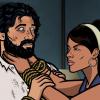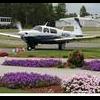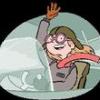Leaderboard
Popular Content
Showing content with the highest reputation on 09/21/2012 in all areas
-
copied from BT, who copied it from an Army aviation site. Note, I give out too much advice, but none of this is mine Copied from an Army Aviation Site: • As an aviator in flight you can do anything you want, as long as it's right! And, we'll let you know if its right after you get down. • You can't fly forever without getting killed. • As the pilot of a combat aircraft only two bad things can happen to you and one of them will: a. One day you will walk out to the aircraft knowing that it is your last flight. b. One day you will walk out to the aircraft not knowing that it is your last flight. • Success is being able to walk to your Flight Evaluation Board (FEB). • There are Rules and there are Laws. The rules are made by men who think that they know better how to fly your aircraft than you. The Laws (of Physics) were made by the Great One. You can, and sometimes should, suspend the rules but you can never suspend the Laws. • More about Rules: a. The rules are a good place to hide if you don't have a better idea and the talent to execute it. b. If you deviate from a rule, it must be a flawless performance.(i.e. If you fly under a bridge, don't hit the bridge.) • The Cavalry pilot is the highest form of life on earth. • The ideal Cavalry pilot is the perfect blend of discipline and aggressiveness. • About check rides: a. Having someone climb into your aircraft to grade how you fly is just like having someone come into your bedroom to grade how you screw. b. The only real objective of a check ride is to complete it and get the bastard out of your aircraft. c. It has never occurred to any instructor pilot during an evaluation that the examinee could care less what the IP's opinion of his flying ability really is. • The medical profession is the natural enemy of the aviation profession. • The job of the Troop Commander is to worry incessantly that his career depends solely on the abilities of his aviators to fly their aircraft without mishap and that their only minuscule contribution to the effort is to bet their lives on it. • Ever notice that the only experts who decree that the age of the pilot is over are the people who have never flown anything? Also, in spite of the intensity of their feelings that the pilot's day is over I know of no such expert who has volunteered to be a passenger in a non-piloted aircraft. • It is absolutely imperative that a pilot be unpredictable. Rebelliousness is very predictable. In the end, conforming almost all the time is the best way to be unpredictable. • He who demands everything that his aircraft can give him is a pilot; he that demands one iota more is a fool. • If you're gonna fly high, do not fly slow! • It is solely the pilot's responsibility to never let any other thing touch his aircraft. • If you can learn how to fly as a WO1 and not forget how to fly by the time you're a CW5 you will have lived a happy life. • About night flying: a. Remember that the aircraft doesn't know that it's dark. b. On a clear, moonless night, never fly beneath the inverted Y. c. There are certain aircraft sounds that can only be heard at night. d. If you're going to night fly, it might as well be in the weather so you can double count your exposure to both hazards. e. Tight night formation is really an endless series of near misses in equilibrium with each other. f. You would have to pay a lot of money at a lot of amusement parks and perhaps add a few drugs, to get the same blend of psychedelic sensations as a single night multiship operation in poor weather. • One of the most important skills that a pilot must develop is the skill to ignore those things that were designed by non-pilots to get the pilot's attention. • At the end of the day, the controllers, ops supervisors, maintenance guys, weather guessers, and birds; they're all trying to kill you and your job is to not let them! • The concept of "controlling" airspace with radar is just a form of FAA sarcasm directed at pilots to see if they're gullible enough to swallow it. Or to put it another way, when is the last time the FAA ever shot anyone down? • Remember that the radio is only an electronic suggestion box for the pilot. Sometimes the only way to clear up a problem is to pull the pin. • It is a tacit, yet profound admission of the pre-eminence of flying in the hierarchy of the human spirit, that those who seek to control aviators via threats always threaten to take one's WINGS and not one's life. • Mastering the prohibited maneuvers in the -10 is possibly one of the best forms of aviation life insurance you can get. • A tactic done twice is a procedure. (Refer to unpredictability discussion above) • The aircraft's -10 chapter 5 limits are only there in case there is another flight by that particular aircraft. If subsequent flights do not appear likely, there are no limitations. • One of the beautiful things about a single-pilot aircraft is the quality of the social experience. • If a mother has the slightest suspicion that her infant might grow up to be a pilot she had better teach him to put things back where he got them. • The ultimate responsibility of the pilot is to fulfill the dreams of the countless millions of earthbound ancestors who could only stare skyward and wish. For maximum attention it's hard to beat a good big mistake1 point
-
Yes, there is Most folks had 'both' under that gender symbol, and many don't indicate their model, year, home base or even their name. I've had to deal with identity theft, but being so secretive, while asking for life impacting advise is silly, IMHO, of course.1 point
-
It makes a noticeable difference on the E/F cowls and inductions systems, and almost none on the J cowls/induction system. In fact, Mooney removed it from the later model J's as the cost and weight was not worth the benefit, and they published a SB that gave instructions for removing it in the field. I did this prior to painting my plane and like the cleaner cowl, and especially the loss of that really expensive rubber seal that is easily damaged.1 point
-
The LoPresti cowl has a very effective ram air system (see their video). At the 7500:/8500 range I get a full inch increase in MP - a bit less at higher altitudes. Nice "free" boost in MP. % HP increases, which increases fuel flow somewhat, and most importantly, speed. Usually this is 2-3 knots.1 point
-
Weighing the plane shouldn't have to be a "roll of the dice". Write your previous empty weight on your left forearm with a Sharpie marker. Push it on the scale, if the weight it shows is less than your left arm, write it up and pay your A&P. If it weighs more, push it off, give your A&P a 12-pack, and go hunting or something. as an emergency measure you can always let 40 pounds of air out of each tire, and drain a gallon of oil to get it under the old weight.1 point
-
I found my Mooney 3 weeks before my PPL checkride, and had to ignore it to concentrate on flying. Then I bought it. Fresh low-time pilots with Zero Retract time are difficult to insure, even as named pilots. While there is nothing wrong with training in a Mooney, I would recommend getting to solo or beyond in the flight school rental. Learn to land on someone else's landing gear, not retractable gear that you have to maintain and repair. Then start blending flights in both airplanes, and finish up in the Mooney. Recognize in advance that this will take longer--more flying time, more instructor time, more months to get your certificate. The down market certainly makes buying a trainer less expensive, but then you will need to sell it to someone. "Buy your second airplane first" is a good approach, and it has worked well for me. George Perry has a great thread on this site from a couple of years ago about what to look for in a Vintage Mooney. It is lengthy and full of excellent advice. Use the "Search" box. The important part is to buy a well-maintained airplane, watch out for certain Mooney-specific problem areas and do not be in a hurry to find the right one. Best of luck to you! Please let us know how it goes for you, and if you have any questions.1 point
-
I concur. Sure, you could train from the beginning in a Mooney, but there isn't really an upside to doing so IMO, but there is plenty of downside. You will not save any money, and in fact it could cost you a lot more if you bend something, or have a major maintenance issue. I would look for such a Cherokee, or a 150/152 (presuming you can fit in one well enough), or even an old tube-and-fabric taildragger. Any of those planes would be much better suited to learning to fly, and should be easily sellable when you're done and ready to go get that Mooney. I *would* recommend training for the instrument rating in your Mooney, though, vs. something slower and less complex. If you don't want to buy a trainer, then I'd consider looking for a local club or flight school, and work up a good cost estimate to get you past the checkride. At the end of the day, 50 hours of time in your own Mooney will likely cost more than that, and perhaps a lot more.1 point
-
1 point
-
I think the turn coordinator may have gone the way of the ADF and Loran...A valuable tool that still works, but quite possibly has been surpassed. Back in the day it was a nice gyro that could run on electricity and get you out of a tight spot in a pinch....and was a step up from the TNB. The TC offers two things that the AI (directly) does not... standard rate turn and inclinometer for coordination. New back-up AIs have the inclinometer, and standard rate is a function of speed and bank angle. What I don't like about the TC, is it's sensitivity. I was bumping around in clouds the other day and realized that if I lose my AI, the TC does not seem like a real reliable source of information during constant turbulence. If there is a sudden upset, it would be difficult to find where level is in heavy bumps. The AI on the other hand was much more steady. In modern times, I would vote for a back-up AI. Does the Aspen have a simulated inclinometer? Best regards, -a-1 point





